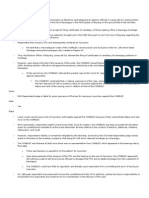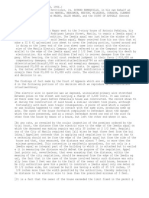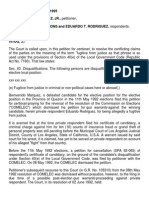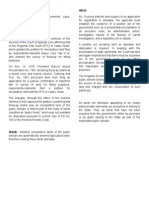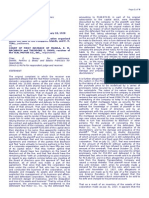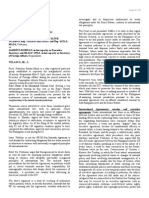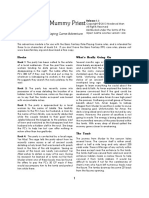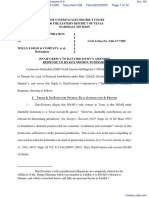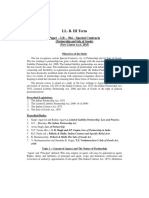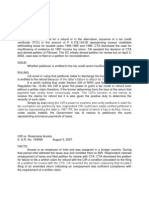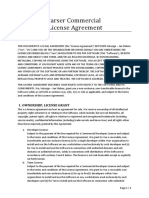Davao Light Vs CA
Davao Light Vs CA
Uploaded by
JL A H-DimaculanganCopyright:
Available Formats
Davao Light Vs CA
Davao Light Vs CA
Uploaded by
JL A H-DimaculanganOriginal Description:
Original Title
Copyright
Available Formats
Share this document
Did you find this document useful?
Is this content inappropriate?
Copyright:
Available Formats
Davao Light Vs CA
Davao Light Vs CA
Uploaded by
JL A H-DimaculanganCopyright:
Available Formats
DAVAO LIGHT & POWER CO., INC., vs.
THE COURT OF APPEALS, QUEENSLAND HOTEL or MOTEL or QUEENSLAND TOURIST INN, and TEODORICO ADARNA, Facts: 1. On May 2, 1989 Davao Light & Power Co., Inc. (hereafter, simply Davao Light) filed a verified complaint for recovery of a sum of money and damages against Queensland Hotel, etc. and Teodorico Adarna (docketed as Civil Case No. 19513-89). The complaint contained an ex parte application for a writ of preliminary attachment. 2. On May 3, 1989 Judge Nartatez, to whose branch the case was assigned by raffle, issued an Order granting theex parte application and fixing the attachment bond at P4,600,513.37. 3. On May 11, 1989 the attachment bond having been submitted by Davao Light, the writ of attachment issued. 4. On May 12, 1989, the summons and a copy of the complaint, as well as the writ of attachment and a copy of the attachment bond, were served on defendants Queensland and Adarna; and pursuant to the writ, the sheriff seized properties belonging to the latter. 5. On September 6, 1989, defendants Queensland and Adarna filed a motion to discharge the attachment for lack of jurisdiction to issue the same because at the time the order of attachment was promulgated (May 3, 1989) and the attachment writ issued (May 11, 1989), the Trial Court had not yet acquired jurisdiction over the cause and over the persons of the defendants. 6. On September 14, 1989, Davao Light filed an opposition to the motion to discharge attachment. 7. On September 19, 1989, the Trial Court issued an Order denying the motion to discharge. 8. On appeal: CA granted the issuance of a writ of preliminary attachment, dated September 19, 1989 denying the motion to discharge attachment; dated November 7, 1989 denying petitioner's motion for reconsideration; as well as all other orders emanating therefrom, specially the Writ of Attachment dated May 11, 1989 and Notice of Levy on Preliminary Attachment dated May 11, 1989, are hereby declared null and void and the attachment hereby ordered DISCHARGED. The Appellate Tribunal declared that . . . While it is true that a prayer for the issuance of a writ of preliminary attachment may be included m the complaint, as is usually done, it is likewise true that the Court does not acquire jurisdiction over the person of the defendant until he is duly summoned or voluntarily appears, and adding the phrase that it be issued "ex parte" does not confer said jurisdiction before actual
summons had been made, nor retroact jurisdiction upon summons being made. . . . 9. Reversal of this Decision of the Court of Appeals of May 4, 1990 is what Davao Light seeks in the present appellate proceedings. Issue: Whether or not a writ of preliminary attachment may issue ex parte against a defendant before acquisition of jurisdiction of the latter's person by service of summons or his voluntary submission to the Court's authority. Held: AFFIRMATIVE It is incorrect to theorize that after an action or proceeding has been commenced and jurisdiction over the person of the plaintiff has been vested in the court, but before the acquisition of jurisdiction over the person of the defendant (either by service of summons or his voluntary submission to the court's authority), nothing can be validly done by the plaintiff or the court. It is wrong to assume that the validity of acts done during this period should be defendant on, or held in suspension until, the actual obtention of jurisdiction over the defendant's person. The obtention by the court of jurisdiction over the person of the defendant is one thing; quite another is the acquisition of jurisdiction over the person of the plaintiff or over the subject-matter or nature of the action, or the res or object hereof. An action or proceeding is commenced by the filing of the complaint or other initiatory pleading. By that act, the jurisdiction of the court over the subject matter or nature of the action or proceeding is invoked or called into activity; and it is thus that the court acquires jurisdiction over said subject matter or nature of the action. And it is by that self-same act of the plaintiff (or petitioner) of filing the complaint (or other appropriate pleading) by which he signifies his submission to the court's power and authority that jurisdiction is acquired by the court over his person. On the other hand, jurisdiction over the person of the defendant is obtained, as above stated, by the service of summons or other coercive process upon him or by his voluntary submission to the authority of the court. The events that follow the filing of the complaint as a matter of routine are well known. After the complaint is filed, summons issues to the defendant, the summons is then transmitted to the sheriff, and finally, service of the summons is effected on the defendant in any of the ways authorized by the Rules of Court. There is thus ordinarily some appreciable interval of time between the day of the filing of the complaint and the day of service of summons of the defendant. During this period, different acts may be done by the plaintiff or by the Court, which are unquestionable validity and propriety. This, too, is true with regard to the provisional remedies of preliminary attachment, preliminary injunction, receivership or replevin.
A preliminary attachment may be defined, paraphrasing the Rules of Court, as the provisional remedy in virtue of which a plaintiff or other party may, at the commencement of the action or at any time thereafter, have the property of the adverse party taken into the custody of the court as security for the satisfaction of any judgment that may be recovered. It is a remedy which is purely statutory in respect of which the law requires a strict construction of the provisions granting it. Withal no principle, statutory or jurisprudential, prohibits its issuance by any court before acquisition of jurisdiction over the person of the defendant. Withal, ample modes of recourse against a preliminary attachment are secured by law to the defendant. The relative ease with which a preliminary attachment may be obtained is matched and paralleled by the relative facility with which the attachment may legitimately be prevented or frustrated. These modes of recourse against preliminary attachments granted by Rule 57 were discussed at some length by the separate opinion in Mindanao Savings & Loans Asso. Inc. v. CA., supra. Two (2) ways of discharging an attachment: first, by the posting of a counterbond; and second, by a showing of its improper or irregular issuance. 1.0. The submission of a counterbond is an efficacious mode of lifting an attachment already enforced against property, or even of preventing its enforcement altogether. 1.1. When property has already been seized under attachment, the attachment may be discharged upon counterbond in accordance with Section 12 of Rule 57. Sec. 12. Discharge of attachment upon giving counterbond. At any time after an order of attachment has been granted, the party whose property has been attached or the person appearing in his behalf, may, upon reasonable notice to the applicant, apply to the judge who granted the order, or to the judge of the court in which the action is pending, for an order discharging the attachment wholly or in part on the security given . . . in an amount equal to the value of the property attached as determined by the judge to secure the payment of any judgment that the attaching creditor may recover in the action. . . . 1.2. But even before actual levy on property, seizure under attachment may be prevented also upon counterbond. The defendant need not wait until his property is seized before seeking the discharge of the attachment by a counterbond. This is made possible by Section 5 of Rule 57. Sec. 5. Manner of attaching property. The officer executing the order shall without delay attach, to await judgment and execution in the action, all the properties of the party against whom the order is issued in the province, not exempt from execution, or so much thereof as may be sufficient to satisfy the applicant's demand, unless the former makes a deposit with the clerk
or judge of the court from which the order issued, or gives a counter-bond executed to the applicant, in an amount sufficient to satisfy such demand besides costs, or in an amount equal to the value of the property which is about to be attached, to secure payment to the applicant of any judgment which he may recover in the action. . . . (Emphasis supplied) 2.0. Aside from the filing of a counterbond, a preliminary attachment may also be lifted or discharged on the ground that it has been irregularly or improperly issued, in accordance with Section 13 of Rule 57. Like the first, this second mode of lifting an attachment may be resorted to even before any property has been levied on. Indeed, it may be availed of after property has been released from a levy on attachment, as is made clear by said Section 13, viz.: Sec. 13. Discharge of attachment for improper or irregular issuance. The party whose property has been attached may also, at any time either BEFORE or AFTER the release of the attached property, or before any attachment shall have been actually levied, upon reasonable notice to the attaching creditor, apply to the judge who granted the order, or to the judge of the court in which the action is pending, for an order to discharge the attachment on the ground that the same was improperly or irregularly issued. If the motion be made on affidavits on the part of the party whose property has been attached, but not otherwise, the attaching creditor may oppose the same by counter-affidavits or other evidence in addition to that on which the attachment was made. . . . (Emphasis supplied) (b) Effect of the dissolution of a preliminary attachment on the plaintiffs attachment bond: . . . The dissolution of the preliminary attachment upon security given, or a showing of its irregular or improper issuance, does not of course operate to discharge the sureties on plaintiff's own attachment bond. The reason is simple. That bond is "executed to the adverse party, . . . conditioned that the . . . (applicant) will pay all the costs which may be adjudged to the adverse party and all damages which he may sustain by reason of the attachment, if the court shall finally adjudge that the applicant was not entitled thereto" (SEC. 4, Rule 57). Hence, until that determination is made, as to the applicant's entitlement to the attachment, his bond must stand and cannot be with-drawn. Petition is GRANTED; the challenged decision of the Court of Appeals is hereby REVERSED, and the order and writ of attachment issued by Hon. Milagros C. Nartatez, Presiding Judge of Branch 8, Regional Trial Court of Davao City in Civil Case No. 19513-89 against Queensland Hotel or Motel or Queensland Tourist Inn and Teodorico Adarna are hereby REINSTATED.
You might also like
- Davao Light v. CA DigestDocument3 pagesDavao Light v. CA Digestkathrynmaydeveza100% (2)
- 279 Zamora V Heirs of IzquierdoDocument2 pages279 Zamora V Heirs of IzquierdoRenz R.No ratings yet
- De Luna vs. Abrigo: 181 SCRA 150Document2 pagesDe Luna vs. Abrigo: 181 SCRA 150Jakie CruzNo ratings yet
- Tan Tiong Bio V BirDocument3 pagesTan Tiong Bio V BirKylie Kaur Manalon DadoNo ratings yet
- Metropolitan Bank & Trust Co v. G & P Builders - CHUADocument2 pagesMetropolitan Bank & Trust Co v. G & P Builders - CHUAJulia UnarceNo ratings yet
- Norkis Trading Corporation vs. BuenavistaDocument1 pageNorkis Trading Corporation vs. BuenavistaOmen CaparidaNo ratings yet
- Andrada Vs PhilhinoDocument12 pagesAndrada Vs PhilhinoRam Rael VillarNo ratings yet
- 544 Vda de Ampil V AlvendiaDocument1 page544 Vda de Ampil V AlvendiaJanelle ManzanoNo ratings yet
- Rizal Commercial Banking Corporation v. Metro Container Corporation, G.R. No. 127913, 13 September 2001Document29 pagesRizal Commercial Banking Corporation v. Metro Container Corporation, G.R. No. 127913, 13 September 2001Ricci Andrea ReyesNo ratings yet
- Laplana Rem Abagatnan v. ClaritoDocument3 pagesLaplana Rem Abagatnan v. ClaritoTen LaplanaNo ratings yet
- 10 Sps. Magtoto v. CADocument1 page10 Sps. Magtoto v. CAEi Ar TaradjiNo ratings yet
- Bardillon v. Barangay Masili (San Pedro)Document2 pagesBardillon v. Barangay Masili (San Pedro)Justine San PedroNo ratings yet
- 28 - City of Iloilo v. Contreras-Besana and Javellana - Consti 2Document2 pages28 - City of Iloilo v. Contreras-Besana and Javellana - Consti 2Cel DelabahanNo ratings yet
- Comelec v. Datu-ImanDocument2 pagesComelec v. Datu-ImanJerome AzarconNo ratings yet
- Adlawan Vs TorresDocument2 pagesAdlawan Vs TorresAngelic ArcherNo ratings yet
- Nilo Raymundo vs. Court of Appeals and Galleria de Magallanes Assoc. Inc., G.R. No. 97805, September 2, 1992Document3 pagesNilo Raymundo vs. Court of Appeals and Galleria de Magallanes Assoc. Inc., G.R. No. 97805, September 2, 1992Lou Ann AncaoNo ratings yet
- 1 OFILDA V. ANDAL G.R. No. 192270 January 26, 2015Document6 pages1 OFILDA V. ANDAL G.R. No. 192270 January 26, 2015SORITA LAWNo ratings yet
- 4 RP V de GuzmanDocument2 pages4 RP V de GuzmanANGELO APORTADERANo ratings yet
- RTC Raymundo V CADocument2 pagesRTC Raymundo V CARose Ann CalanglangNo ratings yet
- Virra Mall Tenants Association Inc Vs Virra Mall Greenhills AssociationDocument1 pageVirra Mall Tenants Association Inc Vs Virra Mall Greenhills AssociationCarlyn Belle de GuzmanNo ratings yet
- La Tondena vs. CADocument2 pagesLa Tondena vs. CADara CompuestoNo ratings yet
- 215 Sambarani v. ComelecDocument3 pages215 Sambarani v. ComelecMiggy CardenasNo ratings yet
- Heirs of Fran v. Salas, G.R. No. L-53546, June 25, 1992 (210 SCRA 303)Document16 pagesHeirs of Fran v. Salas, G.R. No. L-53546, June 25, 1992 (210 SCRA 303)ryanmeinNo ratings yet
- Capa v. CA (Execution)Document3 pagesCapa v. CA (Execution)Katrina Mae MagallanesNo ratings yet
- Rodriguez vs. Iac G.R. No. 74816, March 17, 1987 FactsDocument2 pagesRodriguez vs. Iac G.R. No. 74816, March 17, 1987 FactsNorman jOyeNo ratings yet
- Morata GoDocument4 pagesMorata GoReyshanne Joy B MarquezNo ratings yet
- Cosmos Bottling Corporation v. Nagrama (Insubordination)Document2 pagesCosmos Bottling Corporation v. Nagrama (Insubordination)mariel100% (1)
- PNB v. Intestate Estate of de Guzman DigestDocument3 pagesPNB v. Intestate Estate of de Guzman DigestkathrynmaydevezaNo ratings yet
- Meralco Securities Vs Central Board of Assessment AppealsDocument1 pageMeralco Securities Vs Central Board of Assessment Appealsto be the greatestNo ratings yet
- Baguio, Parilla v. PillarDocument6 pagesBaguio, Parilla v. PillarLorenz BaguioNo ratings yet
- MialheDocument1 pageMialhegeorge almedaNo ratings yet
- Gamogamo v. PNOCDocument2 pagesGamogamo v. PNOCGillian CalpitoNo ratings yet
- 1 Manila Electric V RemoquilloDocument5 pages1 Manila Electric V Remoquilloemmyrea.eNo ratings yet
- Portillo VS Rudolf LietzDocument2 pagesPortillo VS Rudolf Lietzjed_sindaNo ratings yet
- Heirs of Medrano Vs de VeraDocument2 pagesHeirs of Medrano Vs de Verasally deeNo ratings yet
- Barerra V Lorenzo - ValixDocument2 pagesBarerra V Lorenzo - ValixVon Lee De LunaNo ratings yet
- Provisional Remedies GR 96356Document14 pagesProvisional Remedies GR 96356mariaceciliassantiag0% (1)
- 5th List of Cases ProvRemDocument2 pages5th List of Cases ProvRemLala PastelleNo ratings yet
- 1 PubCorp - Mendoza Vs de LeonDocument9 pages1 PubCorp - Mendoza Vs de LeonCristine BilocuraNo ratings yet
- Lantin Vs LantionDocument2 pagesLantin Vs LantionPhilipBrentMorales-MartirezCariagaNo ratings yet
- Dacudao Vs Secretary of Justice Raul Gonzales Digest GR No 188056Document1 pageDacudao Vs Secretary of Justice Raul Gonzales Digest GR No 188056Denee Vem MatorresNo ratings yet
- Malayan v. Victoria's MillingDocument4 pagesMalayan v. Victoria's Millingchappy_leigh118No ratings yet
- 08 Keng Hua Paper Products Co., Inc. v. CA, 349 Phil. 925, 933 (1998)Document7 pages08 Keng Hua Paper Products Co., Inc. v. CA, 349 Phil. 925, 933 (1998)Nikki SiaNo ratings yet
- CD - 14. Tecson VS GutierrezDocument2 pagesCD - 14. Tecson VS GutierrezMykaNo ratings yet
- Finals HR Case DigestDocument3 pagesFinals HR Case DigestWresen AnnNo ratings yet
- Osmena Vs COA - G.R. No. 188818. May 31, 2011Document6 pagesOsmena Vs COA - G.R. No. 188818. May 31, 2011Ebbe DyNo ratings yet
- Cuartero V CADocument2 pagesCuartero V CAiciamadarangNo ratings yet
- Gaboya v. Cui - UsufructDocument6 pagesGaboya v. Cui - UsufructFiona ShakiraNo ratings yet
- Bagalihog Vs Judge Fernandez GR No 96356 June 27 1991Document5 pagesBagalihog Vs Judge Fernandez GR No 96356 June 27 1991Luigi JaroNo ratings yet
- Immaculate Concepcion AcademyDocument1 pageImmaculate Concepcion AcademyTricksterNo ratings yet
- Santiago Case DigestDocument3 pagesSantiago Case Digestlicarl benitoNo ratings yet
- NUEVA ECIJA II ELECTRIC COOP v. MAPAGUDocument2 pagesNUEVA ECIJA II ELECTRIC COOP v. MAPAGUAntonio Dominic Salvador100% (1)
- NTC Vs AlphaomegaDocument11 pagesNTC Vs AlphaomegaMaria Margaret MacasaetNo ratings yet
- 52 Fran Vs SalasDocument2 pages52 Fran Vs SalasDavid Antonio A. EscuetaNo ratings yet
- Torres v. Hon. Teodoro, SR., 101 Phil 422 (1957)Document4 pagesTorres v. Hon. Teodoro, SR., 101 Phil 422 (1957)Dara CompuestoNo ratings yet
- Property Case DigestDocument23 pagesProperty Case DigestsalpanditaNo ratings yet
- MD Transit V GuzmanDocument3 pagesMD Transit V GuzmanMorphuesNo ratings yet
- Citibank, N.A. vs. CADocument2 pagesCitibank, N.A. vs. CAJL A H-DimaculanganNo ratings yet
- 232 Sumifru (Phils.) Corp. v. Spouses CerenoDocument2 pages232 Sumifru (Phils.) Corp. v. Spouses CerenoHBNo ratings yet
- Davao Light V CADocument3 pagesDavao Light V CANikki ZaideNo ratings yet
- Criminal Investigation Course Class 575-2018: By: Public Attorney II, Batangas City District OfficeDocument53 pagesCriminal Investigation Course Class 575-2018: By: Public Attorney II, Batangas City District OfficeJL A H-DimaculanganNo ratings yet
- Motion 2 Withdraw Complaint Blank FormDocument1 pageMotion 2 Withdraw Complaint Blank FormJL A H-DimaculanganNo ratings yet
- IRR RA 9775 Anti Child Pornography ActDocument35 pagesIRR RA 9775 Anti Child Pornography ActJL A H-DimaculanganNo ratings yet
- Employment Under Philippine Labor LawsDocument4 pagesEmployment Under Philippine Labor LawsJL A H-DimaculanganNo ratings yet
- Affidavit of Loss: Republic of The Philippines) City of Batangas) S.SDocument2 pagesAffidavit of Loss: Republic of The Philippines) City of Batangas) S.SJL A H-DimaculanganNo ratings yet
- Rodriguez v. ComelecDocument12 pagesRodriguez v. ComelecJL A H-DimaculanganNo ratings yet
- Chapter 11Document71 pagesChapter 11JL A H-Dimaculangan100% (2)
- Malinao v. ReyesDocument6 pagesMalinao v. ReyesJL A H-DimaculanganNo ratings yet
- Damasen v. TumanaoDocument9 pagesDamasen v. TumanaoJL A H-DimaculanganNo ratings yet
- Sabili Vs ComelecDocument18 pagesSabili Vs ComelecSyElfredGNo ratings yet
- Rivera v. ComelecDocument10 pagesRivera v. ComelecJL A H-DimaculanganNo ratings yet
- Marquez v. ComelecDocument5 pagesMarquez v. ComelecJL A H-DimaculanganNo ratings yet
- Local Govt-Case DigestsDocument16 pagesLocal Govt-Case DigestsJL A H-DimaculanganNo ratings yet
- Estrada V Desierto DigestDocument2 pagesEstrada V Desierto DigestJL A H-DimaculanganNo ratings yet
- Secretary of DENR Vs YapDocument1 pageSecretary of DENR Vs YapJL A H-DimaculanganNo ratings yet
- Altarejos Vs COMELECDocument2 pagesAltarejos Vs COMELECJL A H-DimaculanganNo ratings yet
- Public Interest Vs ElmaDocument1 pagePublic Interest Vs ElmaJL A H-DimaculanganNo ratings yet
- Teal Motor Co. Vs CFIDocument6 pagesTeal Motor Co. Vs CFIJL A H-DimaculanganNo ratings yet
- Bayan Muna Vs Romulo Digest 2011Document2 pagesBayan Muna Vs Romulo Digest 2011JL A H-DimaculanganNo ratings yet
- Gudani Vs SengaDocument3 pagesGudani Vs SengaJL A H-DimaculanganNo ratings yet
- Rizal at The Dominican University of The PhilippinesDocument28 pagesRizal at The Dominican University of The PhilippinesJL A H-DimaculanganNo ratings yet
- Republic Vs GlasgowDocument2 pagesRepublic Vs GlasgowJL A H-Dimaculangan100% (1)
- Statcon 2003 Agpalo Scanned PDFDocument249 pagesStatcon 2003 Agpalo Scanned PDFRen GenNo ratings yet
- Order 59Document10 pagesOrder 59isharkilifatiniNo ratings yet
- State of Nebraska: Funeral Directing and EmbalmingDocument7 pagesState of Nebraska: Funeral Directing and EmbalmingMatthew B. MaupinNo ratings yet
- Jarvis V Williams Jarvis V WilliamsDocument9 pagesJarvis V Williams Jarvis V WilliamsTyler ReneeNo ratings yet
- Order in The Matter of Mafatlal Dyes & Chemicals Ltd.Document2 pagesOrder in The Matter of Mafatlal Dyes & Chemicals Ltd.Shyam SunderNo ratings yet
- Session 5 PWD Form DB/T (2002) Conditions of Contract Conditions of Contract Clause 46 - 62Document34 pagesSession 5 PWD Form DB/T (2002) Conditions of Contract Conditions of Contract Clause 46 - 62Nay Soe NaingNo ratings yet
- Private International LawDocument19 pagesPrivate International LawAp Arc100% (2)
- Dacion en Pago SampleDocument2 pagesDacion en Pago SampleHoney Lyn Co100% (9)
- Tomb of The Mummy PriestDocument7 pagesTomb of The Mummy PriestKaiser Julianus ApostataNo ratings yet
- Spa Buyer SampleDocument1 pageSpa Buyer SampleSharmaine MedianeroNo ratings yet
- Arbitration AwardsDocument3 pagesArbitration AwardsAnonymous lgQ2fB7FcNo ratings yet
- New LL AcknowledgementDocument1 pageNew LL AcknowledgementManish JenaNo ratings yet
- Partnership ActDocument34 pagesPartnership ActMadhaan Aadhvick100% (3)
- The Following Extension of Lease Agreement Is Made by and BetweenDocument2 pagesThe Following Extension of Lease Agreement Is Made by and BetweenBC StockNo ratings yet
- Datatreasury Corporation v. Wells Fargo & Company Et Al - Document No. 536Document10 pagesDatatreasury Corporation v. Wells Fargo & Company Et Al - Document No. 536Justia.com100% (1)
- V.2 Fabian v. FabianDocument3 pagesV.2 Fabian v. FabianBeltran KathNo ratings yet
- Business Law Tutorial 3 - Formation of Contract Instructions To StudentsDocument4 pagesBusiness Law Tutorial 3 - Formation of Contract Instructions To StudentsAprilNo ratings yet
- The People of The Philippines Vs Que Po Lay G.R. No. L-6791 29 March 1954 Montemayor, JDocument1 pageThe People of The Philippines Vs Que Po Lay G.R. No. L-6791 29 March 1954 Montemayor, JMae BecherNo ratings yet
- Civil Liberties Union V Executive SecretaryDocument1 pageCivil Liberties Union V Executive SecretaryAljay Labuga100% (1)
- Board Resulotion - ACI-Appointment of Liaison OfficerDocument2 pagesBoard Resulotion - ACI-Appointment of Liaison OfficerB-an Javelosa78% (9)
- Aninon Vs SabitsanaDocument2 pagesAninon Vs Sabitsanaida_chua8023100% (2)
- Rajasthan: District Transport Office, KishangarhDocument1 pageRajasthan: District Transport Office, Kishangarhmohit jainNo ratings yet
- HWDocument6 pagesHWvinayNo ratings yet
- Karnataka (Sandur Area) Inams Abolition Act, 1976Document18 pagesKarnataka (Sandur Area) Inams Abolition Act, 1976Latest Laws TeamNo ratings yet
- 2007 Tax Case DigestsDocument44 pages2007 Tax Case DigestsJeff Hebron50% (4)
- FPDI PDF Parser LicenseDocument4 pagesFPDI PDF Parser LicensesohinNo ratings yet
- So Ping Bun Vs CADocument2 pagesSo Ping Bun Vs CAJesse Nicole SantosNo ratings yet
- TCTDocument2 pagesTCTRene Jane RosendoNo ratings yet
- Case 119 Almario Vs Executive SecretaryDocument3 pagesCase 119 Almario Vs Executive Secretaryangelo doceoNo ratings yet
- Trial Memo CollectionDocument4 pagesTrial Memo CollectionKamille Ellimak100% (2)













